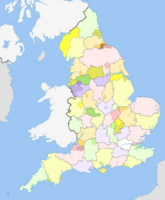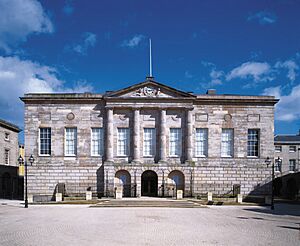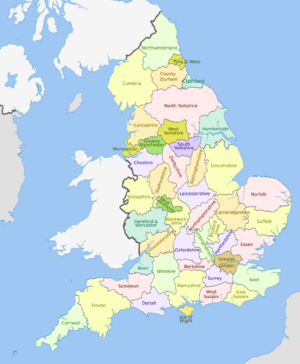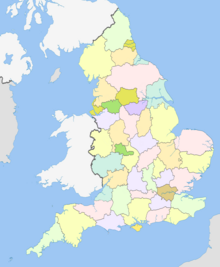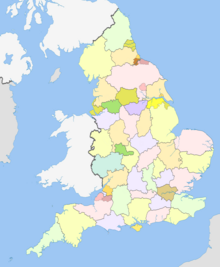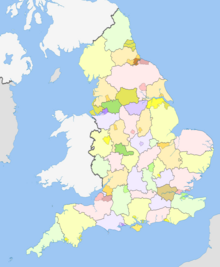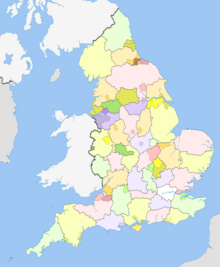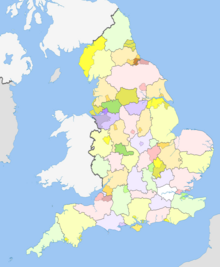Counties of England facts for kids
Quick facts for kids Counties of England |
||||
|---|---|---|---|---|
| Also known as: Shires |
||||
|
||||
| Category | Counties | |||
| Location | England | |||
| Found in | Regions of England | |||
| Created | 1996–1998 (ceremonial) 1974–2023 (local govt) Middle Ages (historic) |
|||
| Possible types | Ceremonial (48) Local government (84) —Metropolitan (6) —Non-metropolitan (78) Historic (39) |
|||
The counties of England are special areas that divide up the country. People have used counties to manage England since the time of the Anglo-Saxons. Today, there are three main ways to think about counties in England.
First, there are 48 ceremonial counties. These are used for special events and for the Lord-Lieutenant, who is the King's representative in that area. Second, there are 84 local government counties. These are used to run local services like schools and roads. These include 6 metropolitan counties (big city areas) and 78 non-metropolitan counties. Third, there are 39 historic counties. These are the very old counties that were used for managing the country until 1974.
The historic counties were mostly created from older kingdoms or divisions. They were first used to help with justice, with a sheriff in charge. Later, they also helped choose members of Parliament and organize the local army, called the militia. Local judges, called magistrates, also started to take on some management jobs.
In 1889, elected county councils were created. These councils took over the management jobs from the magistrates. The way counties work and their areas have changed many times since then. Big changes happened in 1889, 1965, and 1974.
After the 1974 changes, most of England had two levels of local government. There were larger county councils and smaller district councils. Each county was either a metropolitan or non-metropolitan county. Since 1995, many unitary authorities have been set up. These are single councils that do both county and district jobs.
Today, local government counties cover all of England except Greater London and the Isles of Scilly. There are six metropolitan counties and 78 non-metropolitan counties. Some non-metropolitan counties still have two levels of councils. Others are run by a single unitary authority. Berkshire is unique, with six unitary authorities but still legally one county.
For ceremonial purposes, England (including Greater London and the Isles of Scilly) has 48 counties. These are made up of one or more local government counties. Counties are also used for many other things. This includes culture, tourism, and sports. Many clubs and groups are organized by county.
Contents
History of English Counties
How Counties Began
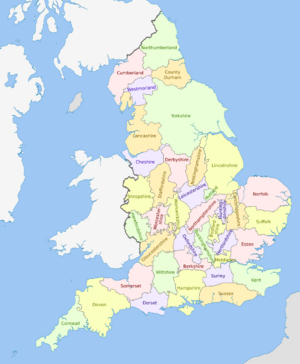
Most of England's historic counties were formed between the 7th and 11th centuries. They were first used to manage justice and the local army. A sheriff was in charge of these tasks. In some special cases, called counties palatine, someone else appointed the sheriff. For example, the Bishop of Durham appointed the sheriff for County Durham.
Local judges met four times a year to handle cases. More serious cases were heard by judges who visited each county twice a year. In larger counties, like Yorkshire (which had "Ridings"), these meetings were held in different parts. These judges also started to manage things like roads and bridges.
When Parliament started in the 13th century, counties helped elect members. Some towns had their own representatives. The rest of the county elected "knights of the shire."
From the Tudor times, a lord-lieutenant was appointed. They took over some of the sheriff's jobs, like overseeing the local army. Some larger towns became self-governing "counties corporate." This meant they had their own courts and sheriffs. These towns were still part of the wider county for ceremonial purposes.
The way counties elected members of Parliament changed after 1832. Most counties were divided into smaller areas for elections.
County boundaries sometimes changed, for example, due to new laws about land. Before the 1800s, county borders were not precisely recorded. They were known by local people and customs. When the Ordnance Survey started making maps, they had to ask locals to find the exact boundaries. Many counties also had small parts, called exclaves, that were separated from the main county. Most of these were removed by boundary changes in 1844.
New laws in 1834 created "poor law unions." These were groups of parishes that often crossed county lines. These unions were used for recording births, deaths, and marriages. They also formed the basis for local government services later on.
The county of Westmorland was formed in 1227. From then until 1889, there were generally 39 counties in England. Sometimes, Monmouthshire was also counted as an English county. The 39 historic counties were:
- Bedfordshire
- Berkshire
- Buckinghamshire
- Cambridgeshire
- Cheshire
- Cornwall
- Cumberland
- Derbyshire
- Devon
- Dorset
- Durham
- Essex
- Gloucestershire
- Hampshire
- Herefordshire
- Hertfordshire
- Huntingdonshire
- Kent
- Lancashire
- Leicestershire
- Lincolnshire
- Middlesex
- Norfolk
- Northamptonshire
- Northumberland
- Nottinghamshire
- Oxfordshire
- Rutland
- Shropshire
- Somerset
- Staffordshire
- Suffolk
- Surrey
- Sussex
- Warwickshire
- Westmorland
- Wiltshire
- Worcestershire
- Yorkshire
When County Councils Started
By the late 1800s, people wanted to change how English counties were run. Towns and cities had elected councils, but counties did not. Also, some towns had grown across county lines, causing problems. The Local Government Act 1888 aimed to fix these issues. It created elected county councils in 1889. These councils took over the management jobs from the judges.
Some large towns and cities were made "county boroughs." This meant they could run their own county-level services. They were independent from the new county councils. A new County of London was created, covering London and parts of other counties. In counties where judges had met in separate parts, separate county councils were created for each part.
The area controlled by a county council was called an "administrative county." The 1888 Act also changed county boundaries for other purposes, like for judges and sheriffs. This made them match the new administrative counties and county boroughs. For example, Yorkshire kept one sheriff, but each of its "Ridings" had its own county council. In 1890, the Isle of Wight became an administrative county, but it was still part of Hampshire for other purposes.
The way parliamentary areas were defined did not change in 1888. This caused some confusion between the new administrative counties and the older areas used for elections. This was fixed in 1918 when election areas were updated.
The 1888 Act used the term "entire county" for the wider county area, including any county boroughs. Ordnance Survey maps also used "geographical county" to show the wider area.
County boundaries continued to change after 1889. Many changes happened after the Local Government Act 1894. This law said that local districts and parishes could no longer cross county boundaries. The number of county boroughs also grew. In 1931, some parts of Gloucestershire, Warwickshire, and Worcestershire were moved. This helped remove the last remaining separated parts of counties.
County councils slowly gained more responsibilities. They took over education in 1902 and helping the poor in 1930.
Big Changes to Counties
After World War II, there were ideas to completely change local government. A commission was set up in 1945 but its ideas were not used.
New commissions were set up in 1957 and 1958. Their work led to major changes in 1965. The County of London was replaced by Greater London. This new area included most of Middlesex (which was abolished as an administrative county) and parts of other counties. Huntingdonshire merged with the Soke of Peterborough to form Huntingdon and Peterborough. The original Cambridgeshire merged with the Isle of Ely to form Cambridgeshire and Isle of Ely.
Another commission in 1966 suggested a complete redraw of local government areas. It proposed having single councils for most services. However, the government changed in 1970 and decided not to use these ideas.
Instead, the government passed the Local Government Act 1972. This law reorganized local government from April 1, 1974. It created a two-level system of counties and districts across England. The only exceptions were the Isles of Scilly and Greater London. All the old administrative counties and county boroughs were removed.
The 1972 reforms also changed how judicial functions worked. The roles of sheriffs and lieutenants became mostly ceremonial. After 1972, the counties' main jobs were local government and these limited ceremonial roles. The sheriffs were renamed "high sheriffs." Both they and the lieutenants were appointed to the new counties created in 1974.
While the old administrative counties were removed, the wider geographical or historic counties were not officially abolished. However, they no longer had any official jobs.
After the 1974 changes, there were 45 counties. Six of these were "metropolitan counties," covering large urban areas:
The other 39 were "non-metropolitan counties":
- Avon
- Bedfordshire
- Berkshire
- Buckinghamshire
- Cambridgeshire
- Cheshire
- Cleveland
- Cornwall
- Cumbria
- Derbyshire
- Devon
- Dorset
- Durham
- East Sussex
- Essex
- Gloucestershire
- Hampshire
- Hereford and Worcester
- Hertfordshire
- Humberside
- Isle of Wight
- Kent
- Lancashire
- Leicestershire
- Lincolnshire
- Norfolk
- North Yorkshire
- Northamptonshire
- Northumberland
- Nottinghamshire
- Oxfordshire
- Shropshire
- Somerset
- Staffordshire
- Suffolk
- Surrey
- Warwickshire
- West Sussex
- Wiltshire
Most non-metropolitan counties kept the names of historic counties. Their boundaries were similar where possible. However, some boundaries were adjusted to better fit economic areas. For example, part of Berkshire moved to Oxfordshire. This was because it was closer to Oxford than to Reading, Berkshire's main town. Also, Gatwick Airport moved from Surrey to West Sussex. This put it in the same county as the nearby town of Crawley.
Four new non-metropolitan counties were created with new names: Avon, Cleveland, Cumbria, and Humberside. Another, Hereford and Worcester, combined two old county names. Some smaller old counties, like Cumberland and Westmorland, were merged into larger new ones.
More Recent Changes
The metropolitan county councils were removed in 1986. The Greater London Council was also abolished. However, the metropolitan counties and Greater London still existed as legal areas. Their high sheriffs and lieutenants remained, even without the councils. The smaller metropolitan boroughs and London boroughs took over the councils' jobs.
More changes in the 1990s allowed for "unitary authorities." These are single councils that do both county and district jobs. The first was the Isle of Wight in 1995.
In 1996, Avon, Cleveland, and Humberside were abolished. People had not felt much loyalty to these counties. They were split into unitary authorities. Each new authority was legally a new non-metropolitan county and a district. Instead of appointing new lieutenants for these, it was decided to go back to the old way. This meant defining ceremonial counties separately from local government counties.
Several other unitary authorities were created between 1996 and 1998. Many of these were based on larger towns and cities. Becoming unitary authorities gave them back powers they had before 1974. While these are legally non-metropolitan counties, they are usually just called unitary authorities.
The old counties of Rutland, Herefordshire, and Worcestershire also became independent again. Rutland became a unitary authority in 1997. Herefordshire became one in 1998. Worcestershire was re-established as a two-tier county. Berkshire County Council was abolished in 1998. Its six districts became unitary authorities. But unusually, Berkshire itself was not abolished as a non-metropolitan county.
More reforms in 2009 and between 2019 and 2023 created even more unitary authorities. Since 2023, England (outside Greater London and the Isles of Scilly) has 84 metropolitan and non-metropolitan counties for local government. The 48 ceremonial counties have not changed since 1998.
Ceremonial Counties: What Are They?
From 1974 to 1996, the local government counties were also used for ceremonial purposes. The Isles of Scilly were part of Cornwall for these purposes. Greater London was considered two ceremonial counties: the City of London and the rest of Greater London.

As unitary authorities were created in the mid-1990s, it was decided to define ceremonial counties differently. This was like going back to how things were before 1974. At that time, ceremonial areas covered several local government areas. New rules came into effect in 1996. They defined ceremonial counties as either local government counties or groups of them. When Avon, Cleveland, and Humberside were abolished in 1996, their areas were split for ceremonial purposes. For example, Avon's area was divided among Gloucestershire, Somerset, and Bristol.
These rules were then put into the Lieutenancies Act 1997. When Herefordshire, Rutland, and Worcestershire became local government counties again, they also became their own ceremonial areas. The ceremonial counties have not changed their areas since 1998. However, the definitions of which local government areas are included have been updated.
In official laws, these areas are called "counties for the purposes of the lieutenancies." But people often use the informal term "ceremonial county." Since 1996, many local government counties share a name with a larger ceremonial county. For example, the local government county of Gloucestershire is run by Gloucestershire County Council. But the ceremonial county of Gloucestershire also includes the unitary authority of South Gloucestershire.
Here are the ceremonial counties and the local government areas they include:
| Ceremonial county | Local government areas |
|---|---|
| Bedfordshire | Bedford, Central Bedfordshire, Luton |
| Berkshire | Berkshire |
| Bristol | Bristol |
| Buckinghamshire | Buckinghamshire, Milton Keynes |
| Cambridgeshire | Cambridgeshire, Peterborough |
| Cheshire | Cheshire East, Cheshire West and Chester, Halton, Warrington |
| City of London | City of London |
| Cornwall | Cornwall, Isles of Scilly |
| Cumbria | Cumberland, Westmorland and Furness |
| Derbyshire | Derbyshire, Derby |
| Devon | Devon, Plymouth, Torbay |
| Dorset | Dorset, Bournemouth, Christchurch and Poole |
| Durham | Durham, Darlington, Hartlepool, Stockton-on-Tees (north of the River Tees) |
| East Riding of Yorkshire | East Riding of Yorkshire, Kingston upon Hull |
| East Sussex | East Sussex, Brighton and Hove |
| Essex | Essex, Southend-on-Sea, Thurrock |
| Gloucestershire | Gloucestershire, South Gloucestershire |
| Greater London | Greater London except City of London |
| Greater Manchester | Greater Manchester |
| Hampshire | Hampshire, Portsmouth, Southampton |
| Herefordshire | Herefordshire |
| Hertfordshire | Hertfordshire |
| Isle of Wight | Isle of Wight |
| Kent | Kent, Medway |
| Lancashire | Lancashire, Blackburn with Darwen, Blackpool |
| Leicestershire | Leicestershire, Leicester |
| Lincolnshire | Lincolnshire, North East Lincolnshire, North Lincolnshire |
| Merseyside | Merseyside |
| Norfolk | Norfolk |
| North Yorkshire | North Yorkshire, Middlesbrough, Redcar and Cleveland, Stockton-on-Tees (south of River Tees), York |
| Northamptonshire | North Northamptonshire, West Northamptonshire |
| Northumberland | Northumberland |
| Nottinghamshire | Nottinghamshire, Nottingham |
| Oxfordshire | Oxfordshire |
| Rutland | Rutland |
| Shropshire | Shropshire, Telford and Wrekin |
| Somerset | Somerset, Bath and North East Somerset, North Somerset |
| South Yorkshire | South Yorkshire |
| Staffordshire | Staffordshire, Stoke-on-Trent |
| Suffolk | Suffolk |
| Surrey | Surrey |
| Tyne and Wear | Tyne and Wear |
| Warwickshire | Warwickshire |
| West Midlands | West Midlands |
| West Yorkshire | West Yorkshire |
| West Sussex | West Sussex |
| Wiltshire | Wiltshire, Swindon |
| Worcestershire | Worcestershire |
Counties in Culture and Sports
There are no official symbols or flags for all counties. From 1889, new county councils could get coats of arms. These often included traditional symbols of the county. These arms were given to the council, not the area itself. So, some are no longer used if the council no longer exists. Recently, many counties have created their own flags. These were often chosen through competitions or public votes. Some areas also now celebrate "county days."
There are 17 first-class men's county cricket teams. These teams are based on the historic English counties. They play in the County Championship and other top-level games. There are also 19 English minor county teams.
The County Football Associations are also mostly based on English counties. But there are some exceptions. For example, Berkshire and Buckinghamshire share one association.
Postal Counties: How Mail Was Sorted
The Royal Mail always needed postal addresses to include the name of a "post town." This helped them sort mail efficiently. In the past, they also needed the county name. There were even official abbreviations for county names. For many villages, the post town was in a different county. So, the correct address might include a county name where the address was not actually located. For example, Easton on the Hill in Northamptonshire had to include Stamford, Lincolnshire in its address. So, postal counties had different boundaries than geographical counties.
The Royal Mail could not keep up with the county boundary changes in 1965 and 1974. This was because of the cost and because some new counties had names too similar to post towns. For example, Hereford and Worcester, Greater Manchester, and Greater London were not used as postal counties. Humberside had to be split into North and South Humberside for mail.
The Royal Mail stopped using postal counties in 1996. By then, postcodes were well-established and made sorting mail easier.
See also
In Spanish: Condados de Inglaterra para niños



